
1. Presentation
This measure covers a range of possible actions that block access to certain motor vehicles according to different criteria (residence, registration, year of construction, etc.). Vehicle restrictions require the planning of specific areas for minimum car use and increased capacity for other means of transport.
Although it can be implemented as an isolated push measure, this measure is commonly used when improving mobility conditions for soft modes generates conflicts that force the restriction of car mobility conditions. It is a measure applied when there is a need for redistribution of limited public space that works simultaneously as a push measure, reducing car’s competitiveness.
2. Objectives
- Reducing the number of vehicles, leading to congestion and air pollution reduction in specific localized areas.
- Developing or converting existing streets for pedestrians, bicycles and public transportation.
- Revitalizing city centres.
3. Measure’s Importance
Restricting car use coupled with the creation of favourable means for soft mobility provide comfort and safety for cycling, as well as creates an efficient and attractive environment for other active modes of transport. These measures contribute to making the streets more pleasant and less dominated by motorized transport.
1. Good Practices
– This measure should be considered when the improvement of mobility conditions for soft modes generates space conflicts with motorized modes, justifying the redistribution of public space.
– Restrictions based on private motorized vehicles should only be implemented briefly to prevent drivers from circumventing the rules. For example, if there are registration restrictions, drivers can buy a second vehicle.
– Must be associated with other measures that promote transport alternatives (See Bike sharing systems, Integration of bicycle in public transport, Connecting people and public transport).
– It must be associated with other car restriction measures (Car-free zones, Car parking restrictions, Limited speed zones, Road user charging, Parking pricing for vehicles, Car connectivity restrictions).
– Design the intervention taking into account that the streets are used for various purposes, namely, traveling, walking, socializing, businesses and living since streets are the entrance spaces for dwellings.
– Establish basic principles, taking into account the social benefits and costs of each mode of transport and the different street activities.
– Incorporate this measure into a comprehensive traffic management strategy.
– New interventions should have extra signalling to alert new conditions. After a few years, the extra signs may be removed.
– Explain the principles behind the measures to make it clear its importance and impacts (See Information).
– Monitor and reframe measures to meet user needs without compromising sustainable ideals (See Management, Monitoring and Maintenance).
2. Actions
 | Home Zones (Woonerf Zones) Areas where the speed limit is around 15 km/ h applied on local access roads located in residential areas, namely in historic centres or shopping and leisure areas. This type of solution is characterized by the coexistence between different modes of transport, although priority is given to pedestrians and non-motorized vehicles, and motor vehicles only have the right of access to these areas. Very restrictive traffic calming measures are implemented and complemented with street furniture to create a shared space. In these areas, a specific traffic signal is used, which is not yet regulated in Portugal. It is a measure that contributes to the improvement of public space. The goal is to improve the quality of life on residential streets by making them places for people rather than just for motor vehicles, by encouraging people to use the streets in different ways, particularly for children to play. |
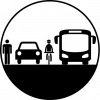 | Shared Streets Many busy and narrow streets already function as shared streets. By removing the formal distinctions between spaces dedicated to pedestrians, cyclists and motor vehicles, the street is shared by everyone, influencing more conscious behaviour in each user. Formal shared streets should be designed with a focus on pedestrians and cyclists, and despite the presence of motor vehicles, they circulate at reduced speed. The shared road removes the traditional segregation between modes of transport and is a quick and inexpensive way to introduce bicycle conditions. they should be implemented in places where pedestrian activity is high and traffic volumes are low or discouraged. These streets can also be marked using different pavements. Coating plays an important role in the “psychological pressure” that measures have on the driver to adopt a particular behaviour. |
 | Partial street closure Restrict the circulation of certain modes of transport by placing signs and / or physical barriers. Measure to be applied in urban centres and residential areas. For example, certain streets may introduce removable barriers to allow only residents' vehicles to enter. Note: Certain infrastructures, such as gates, can transmit the idea of closed neighbourhoods, leading to the loss of street's vitality. |
 | Vehicle Restrictions Restrictions based on address of residence, plate registration number, year of construction, etc. For example, vehicles with license numbers ending in 0 or 1 cannot circulate on Mondays and other numbers on other days of the week. This measure is often implemented as a temporary measure during air pollution emergencies or to reduce traffic congestion during major events. |
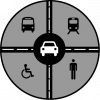 | Traffic cells Divide, temporarily or permanently, the city into cells, which limits cannot be exceeded by private vehicles. However, within each cell, in addition to active means of mobility (walking and cycling), the use of public transport is promoted. |
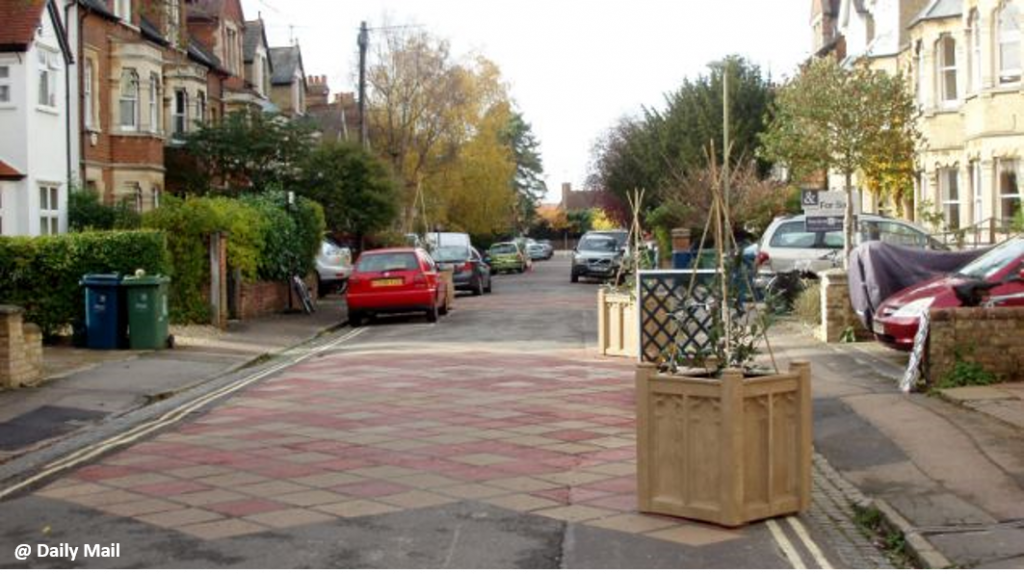
After an accident involving a child, residents of Beach Croft Road (U.K.) placed obstacles on the road to slow down cars. What began with some home furnishings (such as a piano and a fireplace) has evolved to placement of flower beds, benches and roadside paintings.
The entire intervention had about the same cost as 3 road bumps. Costs include around £ 2,000 for paint, £ 4,000 for flower beds, £ 1,000 for trash cans and light poles, £ 1,000 for bicycle racks and £ 2,000. £ for floor reflectors.
The funds were raised by residents and donated by local firms and the City Council. The police, the county and the city council were consulted during the project implementation.
Learn more: youtu.be/lt4b8DtNmd4; www.dailymail.co.uk/news/article-1326361/Stop-cars-speeding-DIY-way-using-plant-pots-drawings-road.html
1. Impacts
 | Mobility system efficiency Depending on the restrictions on car use, these may contribute to reduce delays and improve the reliability of the mobility system. However, by increasing traffic diverted to other areas, efficiency can be reduced. |
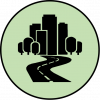 | Livable streets Car-free periods make the streets more attractive. Impacts depend on the size of the intervention area, and time period. More significant impacts can be achieved with the implementation of other strategies. |
 | Protection of the environment When roads are closed to traffic there is a reduction in air and noise pollution and a decrease of the pressure on green spaces and environmentally sensitive places. However, increased traffic diverted to other areas it can be harmful to the environment. |
 | Inclusion, equity and accessibility It improves the conditions of low-cost mobility by creating fair conditions for disadvantaged people, especially if the restrictions include special exemptions for vehicles for people with reduced mobility. |
 | Safety and comfort Reducing car traffic increases safety for pedestrians and cyclists. In addition, it promotes more livable streets, which also reinforces the perception of safety. |
 | Economic value Several studies show that reducing car traffic and improving conditions for pedestrians and cyclists significantly increases local store sales and properties value. |
 | Awareness and acceptability Streets with limited car traffic provide an opportunity to experiment with other mobility options and experience the city in a more humane built environment, helping to break down barriers and raise awareness to active modes of transport. |
Legend:
| Very positive | Positive | Neutral | Negative | Very negative |
2. Barriers
 | Legal In most cases, there are no obvious legal barriers to implementing cycling networks. |
 | Finance Planning and implementing a cycling network can be an expensive undertaking, although there is a substantial cost difference between cycle tracks, cycle lanes and coexistence. The need to prioritise scarce public funds for a minority of users (in the case of starter cities) is a significant barrier. |
 | Governance The implementation process may involve public authorities and potentially corporations, cycling charities and other interest groups. |
 | Political acceptability In starter cycling cities, as cyclists represent a minority, measures focused on bicycle often have less priority within the policymaking process than those measures related to motorised vehicles. |
 | Public acceptability Support from various groups as well as pro-cyclist lobbies is expected. However, it is also expected the reaction from those who are contrary to investments in cycling, especially if it undermines the investment in other modes of transport or public services. |
 | Technical feasibility The implementation of cycling infrastructure requires careful planning and design. Nevertheless, in comparison to other transport modes, technical requirements are not complex. |
Legend:
| No barrier | Minimum barrier | Moderate barrier | Significant barrier |
3. Budget
| Area | Measure | Unit | Cost | Implementation year |
| Brighton, East Sussex (U.K.) | Shared street, or Woonerf | 200 m | £ 1.75 million | 2007 |
| London (U.K.) | Shared street, or Woonerf | 20 000 m2 | £ 25 million | 2015 |
| Netherlands | Shared street, or Woonerf | 1 m2 | Over £ 25.00 | Mid 1980s |
Case study 1: Car-free zone extension in Mechelen (Belgium)

Mechelen created a traffic plan based on car-limited zones. In the city centre was introduced a limit between 11am and 6pm and a 30km / h limit was set for unrestricted hours. Vehicles are monitored by license plate recognition cameras. Public transport, taxis, and other vehicles with access permit are allowed in the area. Residents, and certain professionals, such as healthcare providers, are entitled to a license. In addition, other connectivity and car parking restrictions were implemented.
Impact*:
 | Mobility system efficiency Since December 2011, the number of vehicles driving into the city has decreased considerably, which may have contributed to reduce congestion and increase efficiency of the mobility system. |
 | Livable streets The increase of the car-free area aims to contribute to a more livable, pleasant and accessible city for all. |
 | Protection of the environment Reducing vehicle traffic should reduce air and noise pollution. |
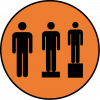 | Inclusion, equity and accessibility According to opposition parties N-VA, CD & V and Vlaams Belang, shop owners and people with disabilities have not been taken into account. |
 | Safety and comfort Decreasing traffic and increasing pedestrian and cycling zones can improve users' perception of safety and comfort. |
 | Economic value No data. |
 | Awareness and acceptability No data. |
* The results of the intervention are currently being studied.
Case study 2: Traffic cells in the city centre, Gothenburg (Sweden)
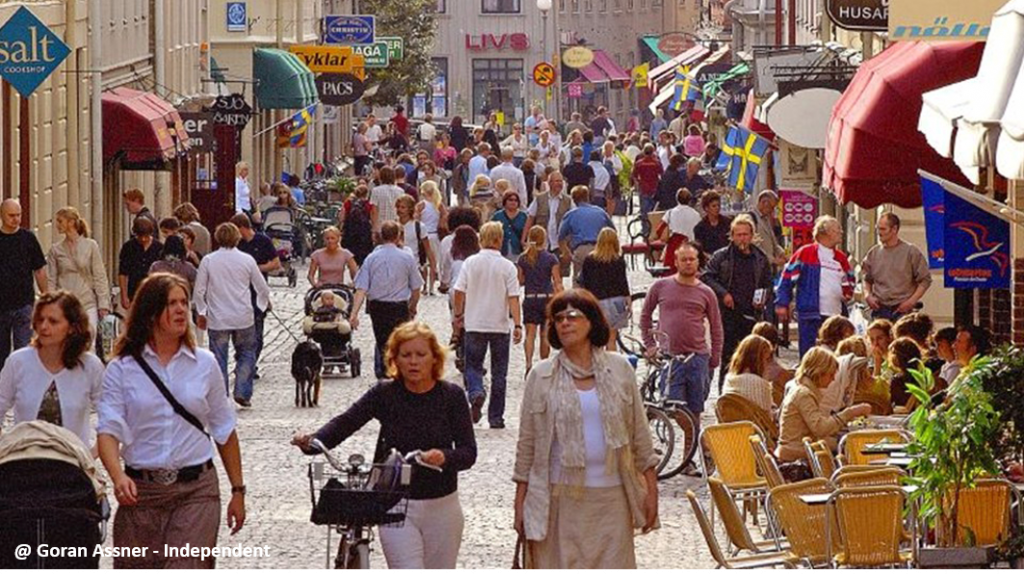
Between 1970 and 1980, the centre was divided into five cells, which could not be crossed by private vehicles. The cells were surrounded by an inner ring road that functioned as a detour for traffic and allowed entry and exit to and from the different sectors. Only pedestrians, cyclists, public transport and emergency vehicles were allowed to cross borders between areas. In later years, streets were pedestrianized, the public transport was prioritized, car parking places were reduced and the price increased to promote the implementation of new cells.
Impact:
 | Mobility system efficiency In the first year, time savings in public transport saved SEK 2 million. In other transport, time savings saved SEK 0.5 million. |
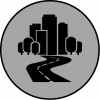 | Livable streets No data. |
 | Protection of the environment Overall, noise pollution in the city centre has been reduced. |
 | Inclusion, equity and accessibility No data. |
 | Safety and comfort Between 1970 and 1982 traffic accidents were reduced by 45%, leading to a saving of SEK 2.2 million. |
 | Economic value No data. |
 | Awareness and acceptability Downtown traffic has halved. It is reasonable to assume that the mind-set has changed. |
Legend:
| Very positive | Positive | Neutral | Negative | Very negative |
Autoluwe zone (2014) Mechelen Mapt. Accessed 18 June 2019. Available at: http://mechelen.mapt.be/wiki/Autoluwe_zone
Department for Transportation (2005) Home Zones: Challenging the Future of Our Streets, London DfT.
KonSULT. Knowledgebase on Sustainable Urban Land use and Transport. (2014). Physical Restrictions. Accessed 18 June 2019. Available at http://www.konsult.leeds.ac.uk/pg/12/#a
Long, K. (2010). Slow down, it’s a turtle! Neighbours paint street mural. The Seattle Times. Retrieved 8 July 2019. Available at: https://www.seattletimes.com/seattle-news/slow-down-its-a-turtle-neighbors-paint-street-mural/
VTPI. Victoria Transport Policy Institute (VTPI) (2018). Vehicle Restrictions. Online Transportation Demand Management (TDM) Encyclopedia. Accessed on 18 June 2019. Available at: http://www.vtpi.org/tdm/tdm33.htm
